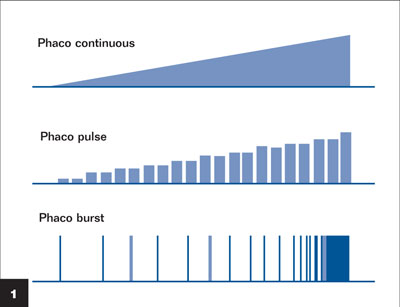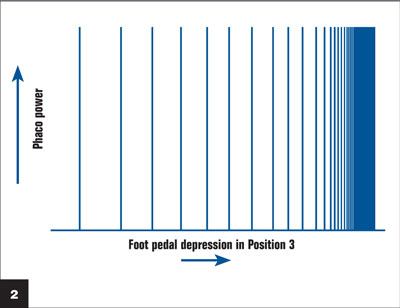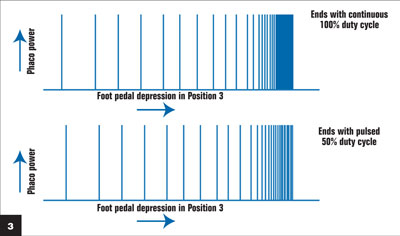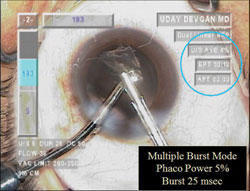Phaco burst mode differs from phaco pulse mode

Surgeons are used to the concept of “continuous” phaco energy delivered in a linear fashion; as the phaco foot pedal is depressed, the energy level increases. Pulse mode gives the same linear control of phaco energy, however, the energy is always delivered in pulses. Burst mode uses specific and identical bursts of phaco energy; as the foot pedal is depressed, these identical bursts of energy are delivered more rapidly, until the interval of time between bursts is infinitely small (Figure 1).
Burst mode allows a true phaco-assisted aspiration of the lens nucleus. We use the vacuum and fluidics of the phaco machine to aspirate the cataract, and then use small bursts of phaco energy only when necessary. Because we can program these bursts of phaco power to be very short (as quick as a few milliseconds), we can effectively give hundreds of tiny bursts and still use less than 1 second of total phaco time.
Foot pedal depression
 Uday Devgan |
Because the phaco foot pedal now controls the rest interval between identical bursts, we do not have linear control of the phaco power level. For this reason, it is important to use a lower phaco power setting when using burst mode as compared to pulse or continuous modes. When the foot pedal is maximally depressed, the rest interval between bursts is zero and the phaco probe essentially delivers continuous energy (Figure 2).
For surgeons using a divide-and-conquer technique of surgery, the foot pedal can be maximally depressed during grooving, thereby delivering continuous phaco energy to facilitate sculpting of the nucleus. Then to remove the quadrants, the foot pedal is only partially depressed in position 3 so that only bursts of power are used for segment removal. Finally, for epinucleus removal, the foot position 3 is barely entered and just a few bursts of energy are delivered for removal of the softer cataract portions.
Single vs. multiple burst
Most phaco machines have two settings for burst mode: single burst and multiple burst. Single burst delivers just one single burst of energy, for burying the phaco probe into a nucleus for chopping. I never use this mode, but instead prefer multiple burst mode because I can still deliver one single burst by barely entering foot position 3, and I still have the ability to deliver many more bursts at varying intervals with further foot pedal depression.
Finally, we can program an endpoint for burst mode. If we wanted to prevent the machine from delivering continuous energy, for use with sleeveless bimanual microincision phaco for example, we could program this. Some phaco machines will accept a “minimum interval” so that it will not become a zero interval. Other platforms will allow you to program an “endpoint duty cycle,” so that the machine will always give an interval rest period of the same duration as the burst of energy, thereby giving you an endpoint pulse mode with a 50% duty cycle (Figure 3).
For my technique of quick chop, I typically use just one phaco setting: multiple burst mode with a burst time of 20 milliseconds, a power of 10% and an endpoint duty cycle of 50%. This means that I can give 50 of these identical bursts at 10% power to equal just 1 second of continuous phaco at 10% power. Or in absolute terms, I can give 500 of these identical bursts at 10% power to equal just 1 second of continuous phaco at 100% power. It comes as no surprise that most cataracts can be removed with an energy equivalent that is less than 2 seconds of absolute power at 100%.
This low energy delivery in burst mode makes surgery safer by minimizing heat production and by minimizing endothelial cell damage from the ultrasound power. This translates to clear corneas immediately after surgery, better visual outcomes, and most important, higher patient satisfaction. I encourage you to try burst mode.
In the next column, we will focus on further modulations of phaco power: variable rise times.
|
Images: Devgan U |
For Your Information:
- Uday Devgan, MD, FACS, can be reached at the Maloney Vision Institute, 19021 Wilshire Blvd. #900, Los Angeles, CA 90024; 310-208-3937; fax: 310-208-0169. Dr. Devgan is a paid consultant for Bausch & Lomb and AMO and has received award monies from Alcon.




